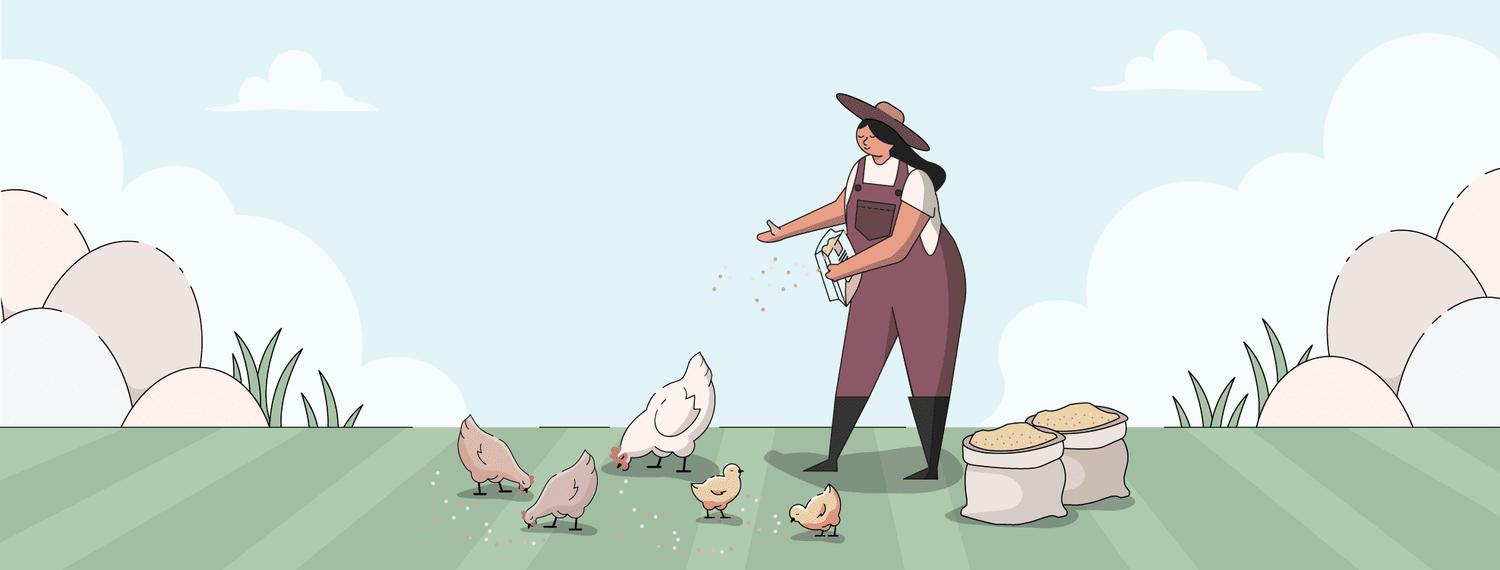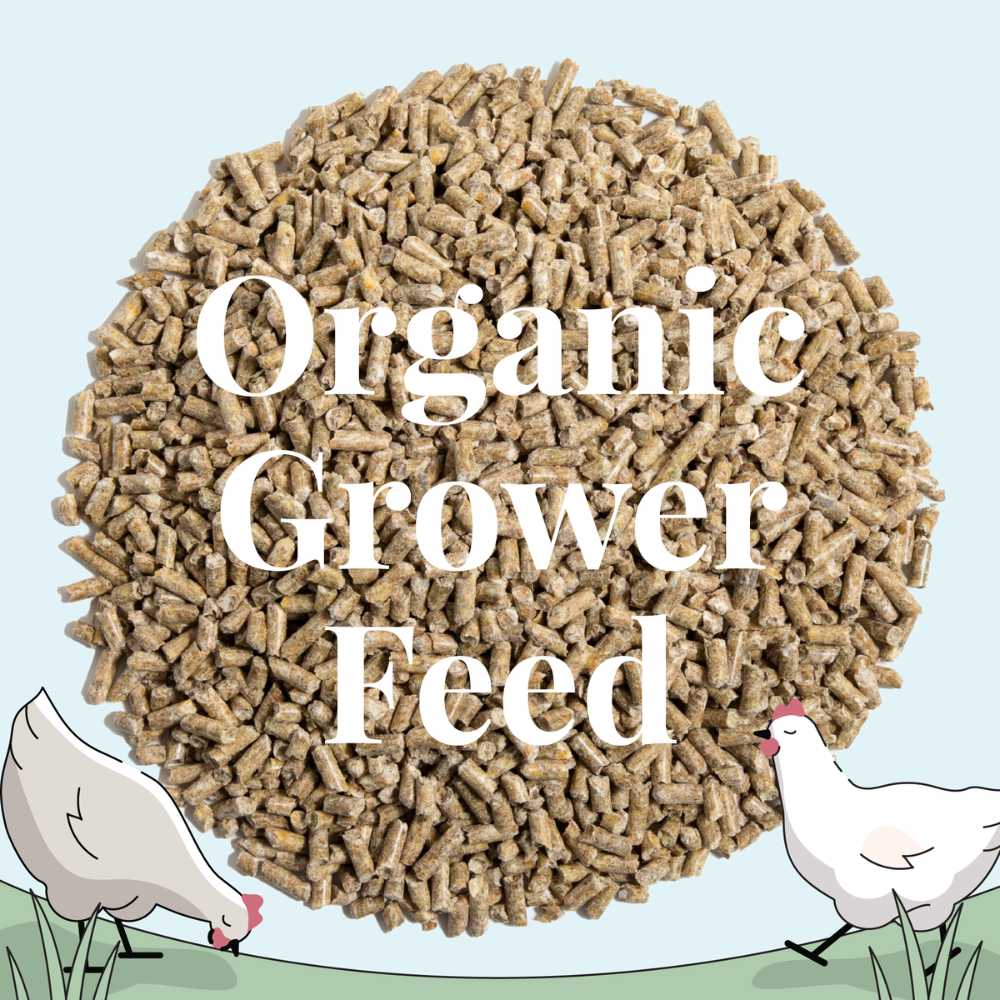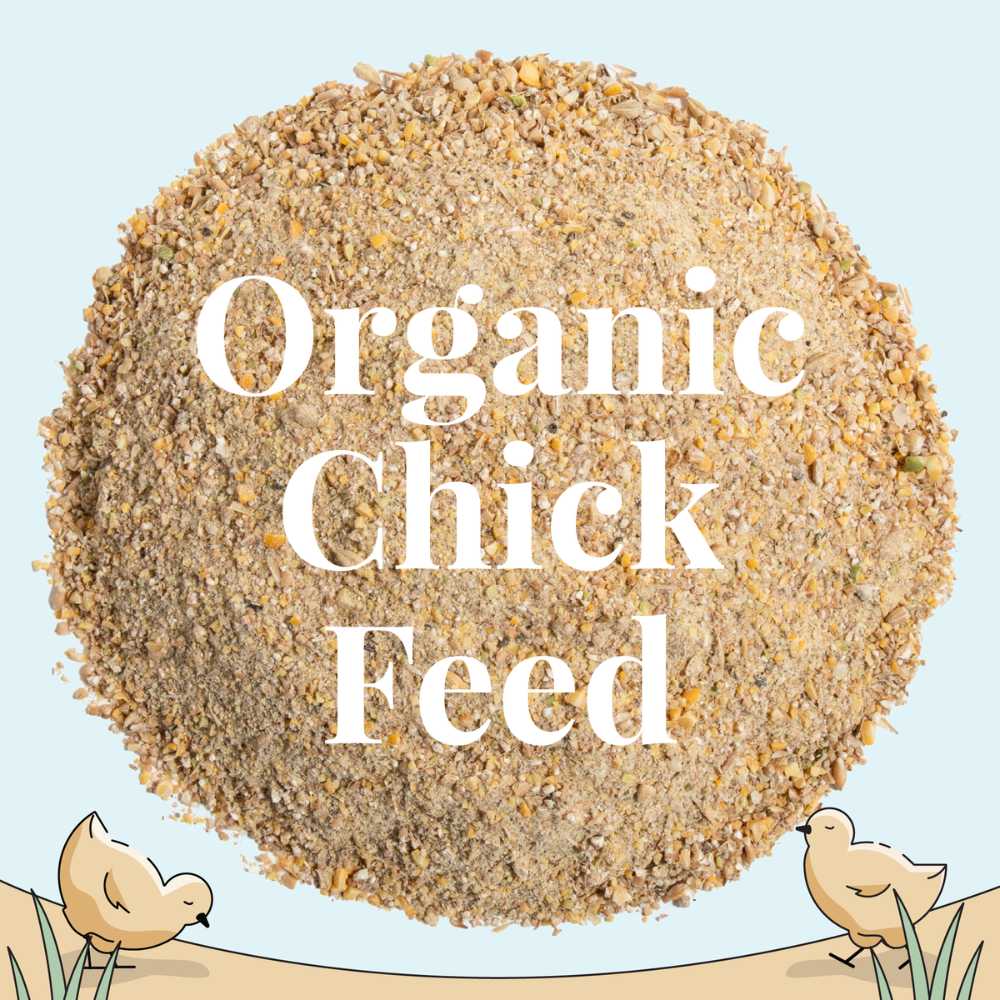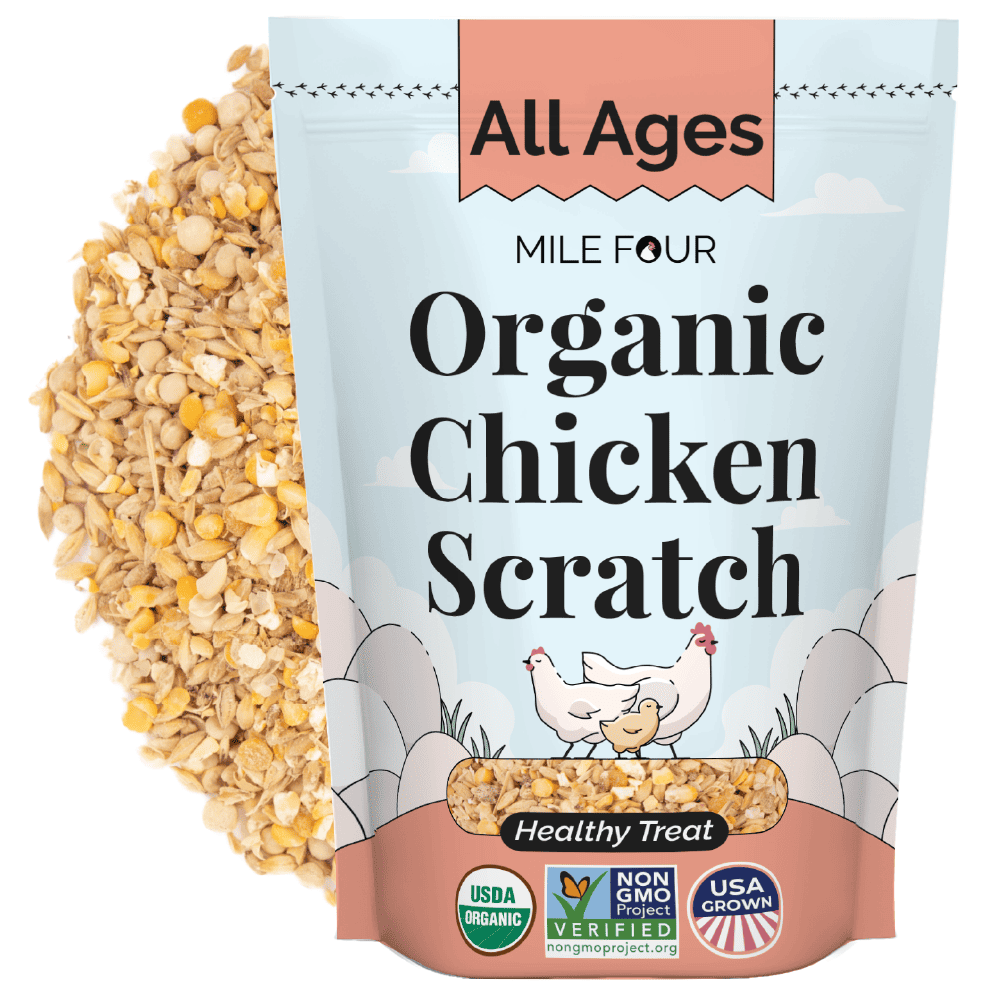Feeding chickens shouldn’t feel like solving a mystery. Yet, with so much information out there, it’s easy to feel unsure about what’s best for your flock. That’s why we’ve updated our old guide—to provide straightforward, practical advice on chicken feed so you can keep your birds happy and thriving.
Whether you’re raising backyard hens, broilers, or chicks, understanding their nutritional needs is essential. From selecting the right organic chicken feed to making seasonal adjustments, we’ll walk you through it all. Think of this guide as your go-to reference for providing top-quality nutrition that leads to healthier chickens and better eggs.
Quick Jump
Chapter 1: Chicken Feed Types & Forms
Chapter 2: Essential Components
Chapter 3: Chicken Treats & Supplements
Chapter 4: Understanding Chicken Feed Consumption
Chapter 5: Chicken Feed Transitioning Guides
Chapter 6: Practical Tips and FAQs
Chicken Feed Types & Forms

When it comes to chicken nutrition, understanding Chicken Feed Types and Chicken Feed Forms is essential. Feed Types are tailored to different stages of a chicken's life—starter feed helps chicks grow, grower feed supports young pullets, and layer feed promotes egg-laying.
Feed Forms, on the other hand, are about how the feed is presented. Think of it like cereal—you can have it in flakes, puffs, or granola form. Similarly, chicken feed comes as pellets, whole grain, or mash, each offering different benefits based on your chickens’ preferences. Just like you might enjoy a different cereal depending on the mood, your chickens will have their preferences too!
Chicken Feed Types
-
Starter Chick Feed – High-protein formula essential for early chick growth.
-
Grower Chicken Feed – Supports pullets transitioning to adulthood before egg-laying.
-
Layer Chicken Feed – Formulated to strengthen eggshells and maintain hen health. Perfect for roosters as well.
-
Broiler Feed – Designed for rapid weight/muscle gain in meat birds.

Chicken Feed Forms
-
Whole Grain: Composed of cracked grains and other unprocessed ingredients. You can see the ingredients in the feed as it is still in a natural state. The granola-like texture is fun for chickens to eat as it encourages a natural pecking instinct and the pieces are large enough for the chickens to grab.
-
Pellet: The most common form of chicken feed available in the market. They are easy to manage, and the compact cylinders minimize waste. Pellets are processed by grinding up the ingredients and molding them into an oblong shape.
-
Mash: An unprocessed form of feed composed of ground-up grains and other ingredients. Mash is most commonly fed to chicks since it is easier for them to consume. Since mash is so finely ground up, it easily goes to waste on the ground (chickens are messy eaters!). Many people like to ferment their mash to get a thicker texture that is easier to manage. We'll get to fermentation later on in this guide.
-
Crumbles: Essentially pellets that have been broken into smaller, coarse pieces. This form is achieved by partially crushing pellets, resulting in a texture that is easier for younger birds to eat. Crumbles serve as a transitional feed form between mash and pellets, making them ideal for growing chickens.

Most Common Organic Chicken Feed Forms
Other Chicken Feed Options
Not all chickens eat the same way—some need cleaner ingredients, while others benefit from special formulations. These alternatives cater to different needs:
-
Organic Chicken Feed – A GMO-free, all-natural option without synthetic additives or medications. Many organic feeds skip corn and soy, using peas, barley, or sunflower seeds for protein.
-
Fermented Feed – Soaking Whole Grain or Mash for 24-48 hours boosts nutrient absorption, gut health, and digestion while reducing waste. Chickens eat less but get more nutrition.
-
Medicated Feed – Contains coccidiostats to protect chicks from coccidiosis but should not be used if they’ve already been vaccinated.
-
Mixed Feed – Combines whole grains, pellets, or crumbles for variety while ensuring a balanced diet—great for picky eaters.
-
DIY Feed – Allows full control over ingredients, avoiding fillers, but requires careful nutrient balancing to maintain proper chicken nutrition.
Essential Components of Chicken Feed

Understanding the essential components of chicken feed is key to providing a balanced diet that meets your flock’s nutritional needs. Much like how a balanced diet supports your health, chickens require a variety of nutrients to thrive. Chicken feed is made up of energy sources, protein, fats, vitamins, minerals, and other essential additives to support growth, egg production, and overall health.
Common Ingredients
-
Grains – Primary energy source (wheat, oats, barley, corn).
-
Protein Sources – Supports muscle and feather growth (peas, fish meal, alfalfa).
-
Fats & Oils – Provides essential fatty acids (flaxseed, fish oil).
-
Vitamins & Minerals – Boosts immunity and bone strength (calcium, phosphorus, salt, probiotics).
Essential Nutrients by Age
-
Starter (0-8 weeks) – 20-22% protein, 0.9% calcium for rapid growth.
-
Grower (8-20 weeks) – 16-18% protein, 0.8% calcium to maintain steady development.
-
Layer (20+ weeks) – 15-18% protein, 3.5-4.5% calcium to ensure eggshell strength.
Organic Chicken Feed
For those looking to feed their flock the cleanest, most natural diet, organic chicken feed is a great option. This feed is free from synthetic pesticides, GMOs, and fillers, providing healthier nutrition. Many organic brands substitute traditional soy and corn with sunflower seeds, peas, and barley, making it ideal for those seeking corn-free, soy-free alternatives. Organic feed not only promotes better overall chicken health but also enhances egg quality, often leading to richer yolks and better-tasting eggs.
Chicken Treats & Supplements

Raising chickens is like feeding kids—some are picky, others eat anything, and their needs change with the seasons. With the right treats and supplements, you can keep them healthy and productive.
Supplements & Digestion
-
Oyster Shell – Provides essential calcium to support strong eggshells and prevent deficiencies in laying hens. Made from crushed limestone, it ensures consistent calcium absorption.
-
Chicken Grit – Essential for digestion, grit helps break down feed in the gizzard. Even free-range birds benefit from supplemental grit to aid food breakdown.
-
Fermented Feed – Soaking whole grain or mash for 24-48 hours enhances digestion, boosts gut health, and reduces feed waste.
-
Medicated Feed – Contains coccidiostats to prevent coccidiosis in chicks but isn’t needed for vaccinated birds.

Treats & Foraging
-
Chicken Scratch – A mix of cracked corn, wheat, and millet that encourages foraging but should only be 10% of their diet.
-
Grubs – A protein-packed treat that supports growth and feather health, offering vital amino acids.
-
Mealworms – High in protein, mealworms enhance feather production and aid overall vitality.
-
Black Soldier Fly Larvae – Packed with calcium and protein, these larvae boost eggshell strength, making them ideal for laying hens.
Seasonal Treats
-
Summer: Treats like watermelon, berries, and greens can help keep your flock hydrated and cool during hot months.
-
Winter: In colder months, offer high-energy treats like cracked corn to help your chickens stay warm. You can also add some warm oatmeal or boiled eggs for extra protein and warmth.

Importance of Fermenting Feed
Fermenting chicken feed is like transforming plain yogurt into a probiotic powerhouse for your flock. Feed forms like Organic Whole Grain or Organic Mash, when soaked for 24-48 hours, unlock nutrients that improve digestion and boost gut health. Fermentation breaks down anti-nutrients like phytates, making the feed easier to absorb while enhancing flavor and reducing waste.

Here are a few other tips to keep in mind when fermenting chicken feed:
-
If you use a plastic container, make sure it’s BPA-free.
-
Do not seal the jar with a lid. The container must be breathable.
-
It is normal for bubbles to appear on the surface.
-
Make sure there is always enough water during fermentation.
-
Stir up the fermented mixture prior to feeding.
-
Only serve the amount of feed chickens will eat at one time.
-
You can reuse the water and add more feed—it will ferment faster with leftover water.
Understanding Chicken Feed Consumption

Feeding your chickens isn’t just about keeping the feeder full—it’s about knowing how much and what they need based on their stage of life, activity levels, and even the season. Overfeeding can lead to obesity, while underfeeding can reduce egg production and weaken your flock.

Daily Feed Amounts
-
Chicks (0-8 weeks) – Around 0.25 lbs per chick per day (half cup) or roughly 1 lb per week.
-
Growers (8-20 weeks) – About 0.25-0.30 lbs per bird per day (1 cup) or 2 lbs per week.
-
Layers (20+ weeks) – Typically 0.25-0.5 lbs (1 cup) per hen per day or 2 lbs a per week.
Try Chicken Feed Cost Calculator
Adjust portions if your flock free-ranges or if feed is consistently left over. Monitoring consumption helps maintain a balanced diet without waste. These amounts are estimates and can vary based on individual chicken needs, environmental factors, and breed differences.
Protein % Guide
Protein is essential for growth, egg production, and feather health. Here’s a simple breakdown:
-
Chicks (0-8 weeks): 20-22% protein for rapid growth.
-
Growers (8-20 weeks): 16-18% protein for steady development.
-
Layers (20+ weeks): 15-18% protein for consistent egg production.
Excessive protein can cause kidney strain, while too little can lead to poor feathering and egg production. Organic chicken feed offers clean, high-quality nutrition with peas, fish meal, and alfalfa as great soy-free protein alternatives.
Seasonal Adjustments
Your chickens' dietary needs shift with the seasons.
-
Winter: Chickens eat 20-30% more to generate body heat. Offer energy-dense grains and consider adding cracked corn in the evening.
-
Summer: Chickens eat less in hot weather. Keep feed fresh, supplement with hydrating treats like watermelon, and ensure constant access to cool water.
Chicken Feed Transitioning Guides

Switching up your chickens’ feed can feel like changing their favorite meal—it takes a little patience. Whether you’re trying out a new brand or transitioning to organic feed, it’s best to ease them into it gradually. This approach keeps their digestive systems happy and helps them adjust without stress.
Transition by Age
Chicks (0-8 weeks) start on Starter chick feed, gradually transitioning to Grower chicken feed around 7-9 weeks and fully switching by Week 9 to prevent digestive stress. Growers (8-20 weeks) stay on Grower feed until Weeks 19-20. At 20+ weeks, once laying begins, transition to Layer chicken feed for essential calcium and eggshell strength.

Transition from Old Feed
Switching your chickens to a new feed should be done gradually to prevent digestive upset and ensure they accept the change. A slow transition allows their digestive system to adjust while avoiding wasted feed if they’re hesitant.

8-Day Chicken Feed Transition
A quicker transition for chickens that adapt easily to new feed.
-
Days 1: 100% old feed
-
Days 2-3: 25% new feed, 75% old feed
-
Days 4-5: 50% new feed, 50% old feed
-
Days 6-7: 75% new feed, 25% old feed
-
Days 8: 100% new feed
Watch for signs of digestive discomfort (like loose droppings) and adjust if needed. If your chickens hesitate with the new feed, extending each stage slightly can help.
Practical Tips & FAQs

Common challenges come with chicken ownership, but we've got practical tips to help you keep your flock healthy and happy.
Common Feed Misconceptions
-
“Chickens can eat anything.”
Not true! While they peck at scraps, chickens need a balanced diet to avoid nutritional deficiencies and digestive issues. -
“Feed is the same for all breeds.”
Larger breeds like Jersey Giants need more protein, while Bantams eat less. Adjust feed based on breed for optimal health. -
“Organic feed is no different.”
Organic chicken feed is free from GMOs and synthetic additives, promoting better health and nutrient-rich eggs with more Omega-3s. -
“Free-range and pasture-raised are the same.”
Pasture-raised chickens roam freely, eating grass and bugs, while free-range birds may have limited outdoor access. -
“Scraps can replace feed.”
Fresh greens and scraps are great treats but shouldn’t exceed 10% of their diet. Chickens need complete nutrition to stay healthy. Avoid toxic foods like onions and chocolate.
Establishing a Feeding Routine
Chickens thrive on routine, so feeding them at the same time each day helps keep them healthy and happy. Consistent feeding encourages good digestion and minimizes stress. Ideally, feed your flock at dawn and again in the late afternoon. This simulates the natural rhythm of foraging during the day, keeping them active and content.
If you free-feed, make sure the food remains fresh, as stale or spoiled feed can harm your chickens. Check the feed regularly, especially during hotter months when spoilage can occur quickly. Also, make sure that the water provided is fresh and clean. Dirty or stagnant water can lead to health problems and reduce their consumption.
How to Identify Nutritional Deficiencies

-
Feather Loss – Rapid feather loss may indicate a protein deficiency, affecting growth and egg production. Ensure feed has adequate protein levels.
-
Weak Eggshells – Soft or thin eggshells often signal a calcium deficiency. Offer oyster shell or other calcium supplements to strengthen shells.
-
Poor Growth – Slow or stunted growth in chicks and young chickens suggests a lack of essential nutrients, particularly protein. Check feed quality and intake.
-
Behavior Changes – Lethargy, reduced appetite, or unusual behavior may point to vitamin or mineral deficiencies. A balanced diet and supplements can help.
If these issues persist, consult a vet to adjust their nutrition.
Seasonal Feeding Adjustments
Chickens' dietary needs change with the seasons. In colder months, they eat 20-30% more to stay warm and need energy-dense, immune-supporting feed. In hot weather, they eat less, making hydration essential—ensure constant access to fresh water to prevent stress. For extreme cold, supplement with extra protein and fats, like scratch or sunflower seeds, to maintain body temperature.
Storage Tips
Proper feed storage is essential for maintaining its freshness, quality, and nutritional value. Here’s how to keep your chicken feed in optimal condition:

-
Cool, Dry Place: Always store chicken feed in a cool, dry area to prevent mold growth or spoilage. Humidity can quickly ruin the feed, turning it into a breeding ground for bacteria and fungi.
-
Airtight Containers: Store feed in airtight containers to protect it from pests, such as rodents, insects, and birds. Containers should be sealed tightly to prevent exposure to air, which degrades the feed’s nutrients.
-
Use Within 6 Months: It’s a good practice to use feed within 6 months from the date of purchase to ensure that it hasn’t lost its nutritional content. Feed that’s too old can cause digestive issues and deficiencies.
-
Bulk Storage: If you purchase chicken feed in bulk, break it up into smaller portions and store it in sealed containers to ensure the bulk feed remains protected from air and moisture. You can keep the bulk supply in a large, sealed container and pull smaller amounts for daily feeding.
------------
Sources:
U.S. Department of Agriculture - Animal and Plant Health Inspection Service (APHIS)
USDA Feed and Animal Management for Poultry (October 2003)
AMS.USDA Organic Poultry Production for Meat & Eggs
Poultry.Extension.org: Feeds and Feeding of Poultry
Purdue University - Animal Sciences - Requirements for Poultry
------------
Disclaimer:
The information provided in this guide is for educational and informational purposes only and is not intended as professional veterinary or nutritional advice. While we strive to ensure accuracy, poultry nutrition can vary based on breed, age, environmental conditions, and other factors. Always consult with a qualified poultry nutritionist, veterinarian, or local agricultural extension before making changes to your flock’s diet. We assume no liability for any loss, injury, or damages resulting from the use of this information.









